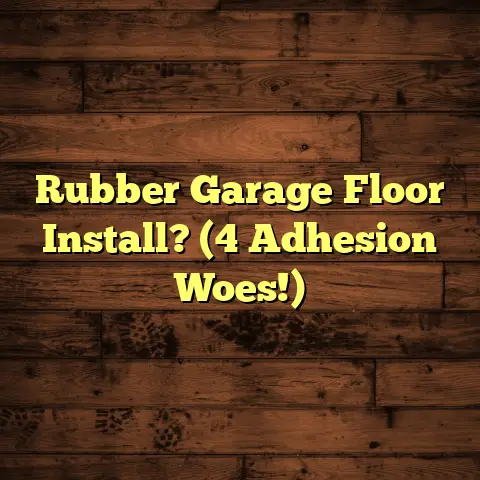DIY Concrete Leveling: Is It Worth It? (1 Mistake!)
Ever tripped on a crack in your garage floor? Or noticed water pooling in your basement? Uneven concrete floors are a real headache.
I’ve seen it all in my years as a flooring contractor. It’s not just an eyesore. It’s a safety hazard and can even damage your property.
Think about it: that slight dip in your living room could be slowly weakening your foundation. And a slanted garage floor? Good luck parking your car straight!
That’s where concrete leveling comes in. And naturally, many homeowners wonder if they can tackle this themselves. DIY concrete leveling is gaining popularity. Why? Because of the promise of saving money and the satisfaction of a job well done.
But is it really worth it? Can anyone grab a bag of self-leveling compound and transform their floors? Let’s dive in and find out.
Understanding Concrete Leveling
So, what exactly is concrete leveling? In simple terms, it’s the process of bringing an uneven concrete surface back to a level plane. We’re talking about fixing dips, slopes, and those annoying cracks that can catch your toes.
The core idea involves adding material to low spots to create a smooth, even surface.
Now, there are a few different ways to achieve this:
-
Mudjacking: This involves pumping a mixture of mud and cement under the slab to lift it.
-
Polyurethane Foam Leveling: Similar to mudjacking, but uses expanding foam. It’s lighter than mud, so it puts less stress on the soil.
-
Self-Leveling Compounds: These are cement-based liquids that you pour onto the floor. They spread out and find their own level. This is the most common method for DIYers.
For DIY, self-leveling compound is usually the go-to. You’ll need a few key tools:
- A concrete grinder for surface prep.
- A mixing drill with a paddle attachment.
- A spiked roller to remove air bubbles.
- A gauge rake to control the thickness.
Now, let’s talk about cost. Hiring a pro for concrete leveling can range from $3 to $30 per square foot, depending on the method and the extent of the damage.
Doing it yourself? You’re looking at material costs, which can vary from $1 to $5 per square foot, plus the cost of renting or buying the tools I mentioned.
| Method | Professional Cost (per sq ft) | DIY Cost (per sq ft) |
|---|---|---|
| Mudjacking | $3 – $15 | Not Recommended |
| Polyurethane Foam Leveling | $5 – $30 | Not Recommended |
| Self-Leveling Compound | $2 – $8 | $1 – $5 |
| (Source: Based on my professional experience and industry averages.) |
So, on the surface, DIY seems cheaper. But remember, that doesn’t factor in your time, potential mistakes, and the learning curve.
Benefits of DIY Concrete Leveling
Alright, let’s talk about the perks of rolling up your sleeves and tackling concrete leveling yourself.
The biggest draw? Cost savings, without a doubt. You’re cutting out the labor costs, which can be a significant chunk of the overall expense.
I’ve had clients tell me they saved hundreds, even thousands, of dollars by doing it themselves.
Then there’s the satisfaction factor. There’s something incredibly rewarding about transforming a problem area in your home with your own two hands.
Plus, a level floor can increase your property value. It makes your home more appealing to potential buyers.
Don’t just take my word for it. I spoke to Sarah, a homeowner who leveled her basement floor herself. “I was intimidated at first, but after watching a few videos, I felt confident enough to try it. It took a weekend, but I saved a ton of money, and I’m so proud of the result!”
And that brings me to another benefit: the accessibility of resources. YouTube is your friend! There are countless tutorials, guides, and forums dedicated to DIY concrete leveling.
Here are some additional benefits of DIY concrete leveling:
- Flexibility: You can work on your own schedule.
- Control: You have complete control over the process and the materials used.
- Learning: You gain valuable home improvement skills.
Of course, it’s not all sunshine and roses. DIY comes with its own set of challenges. And that’s where that one crucial mistake comes in.
The Common Mistake to Avoid
Okay, listen up, because this is where many DIY concrete leveling projects go wrong. The biggest mistake? Inadequate surface preparation.
I can’t stress this enough: proper prep is absolutely critical for a successful outcome.
Think of it like painting. You wouldn’t just slap paint on a dirty, uneven wall, right? The same principle applies here.
Before you even think about pouring that self-leveling compound, you need to thoroughly clean, repair, and assess the existing concrete.
This means:
-
Removing all debris: Dust, dirt, oil, and loose particles will prevent the leveling compound from bonding properly.
-
Repairing cracks and holes: Use a concrete patching compound to fill in any imperfections. Otherwise, the leveling compound will just flow into them, wasting material and potentially creating weak spots.
-
Profiling the surface: Grinding or etching the concrete creates a rough surface that the leveling compound can grip onto.
I’ve seen countless projects fail because homeowners skipped this step. The leveling compound cracks, peels, or simply doesn’t adhere to the existing concrete.
It’s a waste of time, money, and effort. Trust me, spend the extra time on prep. You’ll thank me later.
Step-by-Step Guide to DIY Concrete Leveling
Ready to get your hands dirty? Here’s a detailed guide to DIY concrete leveling:
Step 1: Assess the Area
- Identify the low spots and high spots. Use a level and a straight edge to get an accurate reading.
- Measure the area you need to level. This will help you determine how much leveling compound you need.
- Inspect the concrete for cracks, holes, and damage.
Step 2: Gather Your Supplies
- Self-leveling compound (calculate the amount based on the area and depth needed)
- Concrete grinder or etching solution
- Concrete patching compound
- Mixing drill with paddle attachment
- Spiked roller
- Gauge rake
- Primer (recommended for porous surfaces)
- Shop vacuum
- Safety glasses, gloves, and a dust mask
Step 3: Prepare the Surface
- Clean: Use a shop vacuum to remove all dust and debris. Then, scrub the surface with a concrete cleaner and rinse thoroughly.
- Repair: Fill any cracks or holes with concrete patching compound. Allow it to dry completely according to the manufacturer’s instructions.
- Profile: Grind the surface with a concrete grinder or etch it with an etching solution. This will create a rough surface for better adhesion.
- Prime: Apply a concrete primer to porous surfaces. This will help the leveling compound bond properly and prevent moisture loss.
Step 4: Mix the Leveling Compound
- Follow the manufacturer’s instructions carefully. The water-to-powder ratio is crucial.
- Pour the required amount of water into a large mixing bucket.
- Slowly add the leveling compound powder while mixing with the drill and paddle attachment.
- Mix for the recommended time until you achieve a smooth, lump-free consistency.
Step 5: Apply the Leveling Compound
- Pour the mixed leveling compound onto the prepared surface.
- Use the gauge rake to spread the compound evenly and control the thickness.
- Work quickly, as the compound will start to set within 20-30 minutes.
- Use the spiked roller to remove any air bubbles.
Step 6: Cure the Concrete
- Allow the leveling compound to cure according to the manufacturer’s instructions. This usually takes 24-72 hours.
- Keep the area protected from direct sunlight and extreme temperatures.
- Consider using a curing compound to prevent the concrete from drying out too quickly.
Safety Precautions:
- Always wear safety glasses, gloves, and a dust mask when working with concrete.
- Work in a well-ventilated area.
- Follow the manufacturer’s instructions for all products.
- Be careful when lifting heavy bags of leveling compound.
- If you’re unsure about any step, consult a professional.
Potential Challenges and How to Overcome Them
DIY projects rarely go exactly as planned. Here are some common challenges you might face during concrete leveling and how to tackle them:
-
Curing Time: Concrete needs time to cure properly. If it dries too quickly, it can crack. Solution: Keep the area damp by misting it with water or covering it with plastic sheeting.
-
Temperature Considerations: Extreme temperatures can affect the curing process. Solution: Avoid working in direct sunlight or when temperatures are below freezing.
-
Air Bubbles: Air bubbles can weaken the leveling compound and create imperfections. Solution: Use a spiked roller immediately after pouring the compound to release trapped air.
-
Uneven Application: It’s easy to accidentally apply the leveling compound too thick or too thin in certain areas. Solution: Use a gauge rake to maintain a consistent thickness. If you notice any unevenness, correct it immediately.
-
Compound Setting Too Quickly: Self-leveling compound can start to set quickly, especially in warm weather. Solution: Work in small sections and mix the compound in batches. Have all your tools and materials ready before you start.
I remember one client, Mark, who tried to level his garage floor in the middle of summer. The compound started setting before he could even spread it properly. He ended up with a lumpy, uneven mess.
He called me in to fix it. We had to grind down the entire surface and start over. The lesson? Pay attention to the weather and work in manageable sections.
Here’s a quick troubleshooting guide:
| Problem | Possible Cause | Solution |
|---|---|---|
| Cracking | Rapid drying, improper mixing | Keep the area damp, follow mixing instructions carefully, consider using a curing compound. |
| Air Bubbles | Improper rolling, poor mixing | Use a spiked roller immediately after pouring, mix the compound thoroughly, avoid over-mixing. |
| Unevenness | Inconsistent application | Use a gauge rake, work in small sections, correct any unevenness immediately. |
| Compound Setting Too Fast | High temperature, improper mixing | Work in small sections, mix the compound in batches, have all your tools and materials ready, consider working in the early morning or late evening when it’s cooler. |
Conclusion
So, is DIY concrete leveling worth it? The answer, as with most DIY projects, is: it depends.
If you’re a seasoned DIYer with some experience in concrete work, and you’re willing to put in the time and effort to do it right, then it can be a great way to save money and improve your home.
But if you’re a complete beginner, or if you’re dealing with a large or complex leveling project, it might be best to leave it to the professionals.
Remember that one crucial mistake: inadequate surface preparation. Don’t skip this step! Proper prep is the key to a successful outcome.
Weigh your options carefully. Consider your skills, your budget, and the complexity of the project. And don’t be afraid to ask for help if you need it.
Ultimately, the decision is yours. But armed with the information in this article, you’ll be well-equipped to make an informed choice. Good luck with your concrete leveling project!





